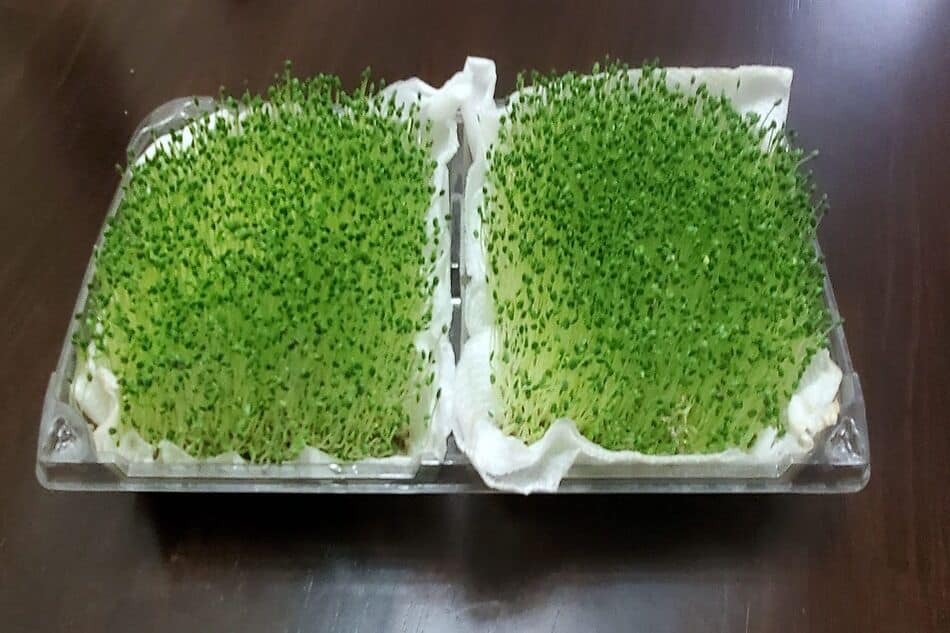All of you may or may not have heard about chia seeds and their numerous benefits, but have you heard about the chia microgreen? If not, then you’re in luck, because in this article, I’ll be talking about chia microgreens, how to grow chia microgreens, the benefits of chia microgreens, and much more.

How To Grow Chia Microgreens
Chia microgreens are a type of sprouted seed that is high in nutrients and antioxidants. They are easy to grow at home and can be used in a variety of ways, such as in salads, sandwiches, and soups. To grow chia microgreens, you will need chia seeds, a growing tray, potting mix, water, and a sunny windowsill. Start by soaking the chia seeds in water for 12 hours.
Then, drain the seeds and spread them evenly on the growing tray. Cover the tray with potting mix, and mist with water. Place the tray on a sunny windowsill, and mist with water daily. After 10 days, the microgreens will be ready to harvest. Cut them close to the soil surface with a sharp knife or scissors.
Enjoy your freshly grown chia microgreens!
I’ve answered the question of how to grow chia microgreens, let’s talk more about it in more detail.
How To Grow Chia Microgreens (Step-by-Step Procedure)
Growing your own microgreens is a great way to get fresh, nutritious greens all year round. Plus, it’s a fun and easy project that the whole family can enjoy.
Here’s a step-by-step guide to growing chia microgreens:
1. Fill a seed tray with organic potting mix and dampen with water.
2. Sow the chia seeds evenly over the surface of the soil.
3. Cover the tray with another layer of damp potting mix or a sheet of black plastic to help keep the soil moist.
4. Place the tray in a warm, sunny spot and water regularly to keep the soil moist.
5. In 7-14 days, you should see the first signs of growth emerging from the soil. Once the microgreens are about 2-3 inches tall, they’re ready to harvest. To do this, simply snip them off at the base with scissors.
6. Rinse the microgreens well and enjoy them in salads, on sandwiches, or as a healthy snack!
Now that I have discussed in much detail how to grow chia microgreens, let’s try and understand the plant now.
What Is Chia?
Chia is a flowering plant in the mint family, native to Mexico and Guatemala. The seeds of the plant are rich in omega-3 fatty acids, fiber, and antioxidants. They can be eaten whole, ground into flour, or used to make a gel. Chia gel can be used as a vegan egg replacement in baking. It is also a popular ingredient in health drinks and energy bars.
Chia seeds are generally considered safe to eat, though people with allergies to mint or other plants in the Lamiaceae family should avoid them. Some potential side effects of consuming large amounts of chia seeds include digestive problems, dehydration, and lowered blood pressure. When used properly, chia seeds can be a healthy addition to the diet.
What Is The Chia Microgreen?
The chia microgreen is a type of edible sprout that is produced from the seeds of the Salvia Hispanica plant. These sprouts are generally harvested when they are between 7-14 days old, and they can be used in a variety of ways, including as a garnish or added to salads.
Chia microgreens are a good source of vitamins A, C, and E, as well as calcium, iron, and magnesium. They also contain high levels of antioxidants and fiber. Because of their nutritional content, chia microgreens have been linked to a number of health benefits, such as improved digestion, reduced inflammation, and better blood sugar control.
Health Benefits Of The Chia Microgreen
Chia microgreens are an excellent source of nutrition. They are a rich source of vitamins A, C, and E, as well as calcium, magnesium, and potassium. They also contain high levels of antioxidants and fiber.
All of these nutrients are important for optimal health. Vitamin A is essential for good vision, skin health, and immune function. Vitamin C helps to heal wounds and maintain healthy bones and teeth. Vitamin E is a powerful antioxidant that helps to protect cells from damage. Calcium helps to build strong bones and teeth, while magnesium helps to regulate blood pressure and keep the heart-healthy. Potassium is essential for proper muscle function and nerve transmission.
Finally, the fiber in chia microgreens helps to promote regularity and maintain a healthy digestive system. Given all of these health benefits, it is no wonder that chia microgreens are becoming increasingly popular among health-conscious individuals.
How To Eat The Chia Microgreen?
The chia microgreen can be eaten in a variety of ways. One popular way is to add it to a salad. The microgreen can also be used as a garnish on soup or as a topping on burgers and sandwiches.
Another way to enjoy the chia microgreen is to juice it. This can be done by adding the microgreen to a juicer along with other fruits and vegetables. The chia microgreen can also be blended into smoothies or blended with water to make a healthy drink.
Whatever way you choose to eat the chia microgreen, you are sure to enjoy its nutritious benefits.
Conclusion
In conclusion, to grow chia microgreens, start by soaking chia seeds overnight in water. Then, drain the seeds and place them on a moist paper towel. Roll the towel up and place it in a warm, dark location for 3-5 days, until the seeds have germinated. Once the seeds have germinated, plant them in the soil and water them regularly. Keep the soil moist but not soggy, and fertilize every 2 weeks with a solution of 1 part water to 1 part liquid seaweed fertilizer. The microgreens will be ready to harvest in 2-3 weeks. After harvesting, cut the greens back to their original height so that they can regrow.
Chia microgreens are a nutritious and flavorful addition to any meal!
I hope after reading this article your knowledge of the chia microgreen and how to grow chia microgreens would have increased.

